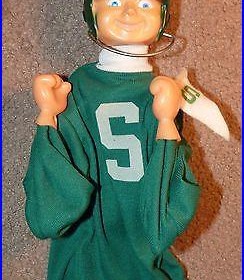
Vintage Michigan State University Spartan Big Ten Bobblehead Action Puppet Msu
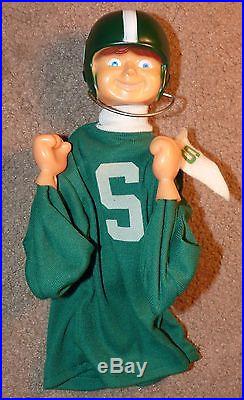
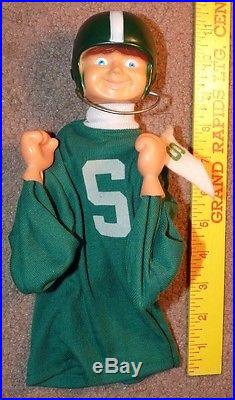
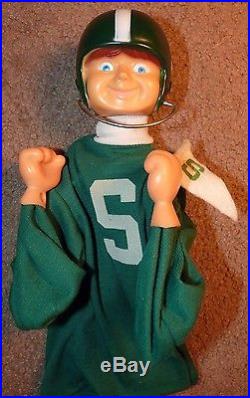


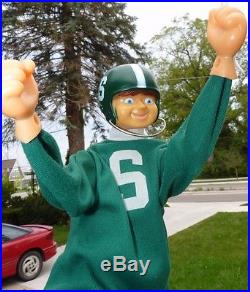

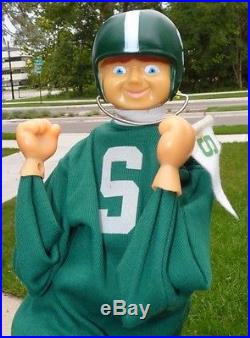

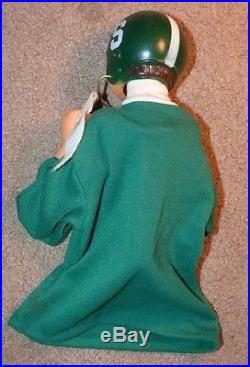

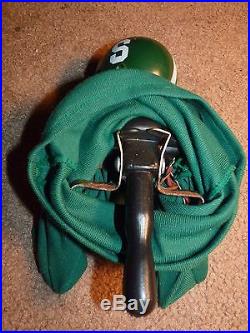

VINTAGE MICHIGAN STATE UNIVERSITY SPARTAN SPARTY BOBBLEHEAD ACTION PUPPET MSU! Great way to show MSU SPARTAN Pride. Great for the Man Cave , Mom Cave , Sports Den , Patio , Deck , Office or SPARTY PARTY! This item will be a FUN addition to MSU SPARTAN collectors , sports collectors and MSU FANS , STUDENTS , FACULTY and ALUMNI. Makes a great gift. Perfect for Game Day! High resolution photos convey condition and details. From Wikipedia, the free encyclopedia. Campus 10,000 acres 8 km. In existing or planned development. Michigan State University (MSU) is a public. Located in East Lansing, Michigan. United States and is the first land-grant institution. That was created to serve as a model for future land-grant colleges in the country under the 1862 Morrill Act. MSU pioneered the studies of packaging. Program is the largest of any single-campus university in the country, offering more than 200 programs in more than 60 countries on all continents including Antarctica. It is considered to be one of America’s Public Ivy. Universities, which recognizes top public research universities in the United States. Following the introduction of the Morrill Act. The college became coeducational. And expanded its curriculum beyond agriculture. Today, MSU is the eighth-largest university. In the United States, with 47,800 students and 2,954 faculty. The school’s nuclear physics. Economics, engineering, business, education, osteopathic medicine. Fisheries and wildlife, forestry. And criminal justice programs are among the nation’s best. MSU’s Division I. Sports teams are called the Spartans. They compete in the Big Ten Conference. In all sports except ice hockey, in which the team is part of the Central Collegiate Hockey Association. Won the Rose Bowl. In 1954, 1956 and 1988 and boasts six national championships. Its men’s basketball team won the NCAA National Championship. In 1979 and 2000 and is currently enjoying a streak of six Final Four. Appearances over the last 13 seasons. MSU men’s ice hockey. In 1966, 1986 and 2007. Cross country has historically been Michigan State’s most successful sport, especially during a four-decade period spanning roughly 19301970 during which the Spartans won eight NCAA championships and numerous other conference and national titles. Main article: History of Michigan State University. Showing the first federal land-grant colleges for their states in 1863. Marks the site of College Hall. Of 1850 called for the creation of an “agricultural school”. Though it was not until February 12, 1855, that Michigan Governor. Signed a bill establishing the United States’ first agriculture college, the Agricultural College of the State of Michigan. Classes began on May 13, 1857, with three buildings, five faculty members, and 63 male students. The first president, Joseph R. Designed a curriculum that required more scientific study than practically any undergraduate institution of the era. It balanced science, liberal arts. The curriculum excluded Latin. And Greek studies, since most applicants did not study any classical languages in their rural high schools. However, it did require three hours of daily manual labor. Which kept costs down for both the students and the College. Despite Williams’ innovations and his defense of education for the masses, the State Board of Education saw Williams’ curriculum as elitist. They forced him to resign in 1859 and reduced the curriculum to a two-year vocational program. In 1860, Joseph R. Became acting lieutenant governor. And helped pass the Reorganization Act of 1861. This gave the College a four-year curriculum and the power to grant master’s degrees. Under the act, a newly created body, known as the State Board of Agriculture, took over from the State Board of Education in running the institution. The College changed its name to State Agricultural College, and its first class graduated in the same year. As the Civil War. Had just begun, there was no time for an elaborate graduation ceremony. The first alumni enlisted to the Union Army. Williams died, and the following year, Abraham Lincoln. Signed the First Morrill Act. Of 1862 to support similar colleges, making the Michigan school a national model. In 1957, the donation of 1,500 acres 6.1 km. In Pontiac Township, Michigan prompted creation of Michigan State University Oakland. This donation was indicative of the University’s benefactor community that continues today. That campus became officially independent in 1970 as Oakland University. The Alice B Cowles House is the official home of the university president and is the oldest existing building on campus. The college first admitted women in 1870, although at that time there were no female residence halls. The few women who enrolled either boarded with faculty families or made the arduous stagecoach. From the early days, female students took the same rigorous scientific agriculture courses as male students. In 1896, the faculty created a “Women Course” that melded a home economics. Curriculum with liberal arts. That same year, the College turned the old Abbot Hall male dorm into a women’s dormitory. It was not until 1899 that the State Agricultural College admitted its first African American student, William O. After graduation, he taught at what is now Tuskegee University. Snyder invited its president Booker T. To be the Class of 1900 commencement speaker. A few years later, Myrtle Craig became the first woman African-American student to enroll at the College. Along with the Class of 1907, she received her degree from U. Commencement speaker for the Semi-Centennial celebration. The City of East Lansing was incorporated in that same year. And two years later the college officially changed its name to Michigan Agricultural College M. During the early 20th century, M. Expanded its curriculum well beyond agriculture. By 1925 it had expanded enough that it changed its name to Michigan State College of Agriculture and Applied Science M. In 1941 the Secretary of the State Board of Agriculture, John A. Became president of the College. He began the largest expansion in the institution’s history, with the help of the 1945 G. Which helped World War II veterans to receive an education. One of Hannah’s strategies was to build a new dormitory building, enroll enough students to fill it, and use the income to start construction on a new dormitory. Under his plan, enrollment increased from 15,000 in 1950 to 38,000 in 1965. In 1957 Hannah continued MSU’s expansion by co-founding Michigan State UniversityOakland, now Oakland University. With Matilda Dodge Wilson. Hannah also got the chance to improve the athletic reputation of M. When the University of Chicago. Resigned from the Big Ten Conference. Hannah lobbied hard to take its place, gaining admission in 1949. Six years later, in its Centennial year of 1955, the State of Michigan renamed the College as Michigan State University of Agriculture and Applied Science. Nine years after that, the University governing body changed its name from the State Board of Agriculture to the MSU Board of Trustees. The State of Michigan. Allowed the University to drop the words “Agriculture and Applied Science” from its name. Since 1964 the institution has gone by the name of Michigan State University. Global leader by 2012. The National Superconducting Cyclotron Laboratory. Features one of the most powerful instruments of its type in the world. Since the end of the Hannah era, Michigan State has shifted its focus from increasing the size of its student body to advancing its national and global reputation. In September 2005, current president Lou Anna Simon. Called for MSU, one of the public ivy institutions. To become the global model leader for Land Grant institutions by the year 2012. Her plans include creating a new residential college. And increasing grants awarded from the National Institutes of Health. While there are over 100 Land-grant universities. In the United States, she has stated that she would like Michigan State University to be the leader. Michigan State, the University of Michigan. And Wayne State University. Created the University Research Corridor. This alliance was formed to transform and strengthen Michigan’s economy by reaching out to businesses, policymakers, innovators, investors and the public to speed up technology transfer, make resources more accessible and help attract new jobs to the state. Main article: Campus of Michigan State University. MSU’s main campus lies north of the CN Railway and south of Michigan and Grand River Avenues. MSU’s sprawling campus is located in East Lansing, Michigan. The campus is perched on the banks of the Red Cedar River. Development of the campus started in 1856 with three buildings: a multipurpose building called College Hall. A dormitory later called Saints’ Rest. Today, MSU’s contiguous campus consists of 5,200 acres 21 km. , 2,000 acres 8.1 km. Of which are developed. There are 556 buildings: 100 for academics, 131 for agriculture, 166 for housing and food service. And 42 for athletics. Overall, the university has 22,763,025 square feet 2,114,754.2 m. Of total indoor space. Connecting it all is 26 miles (42 km) of roads and 100 miles (160 km) of sidewalks. MSU also owns 44 non-campus properties, totaling 22,000 acres 89 km. In 28 different counties. The oldest part of campus lies on the north bank of the Red Cedar. It includes Collegiate Gothic. Architecture, plentiful trees, and curving roads with few straight lines. It was in this area that the College built its first three buildings, of which none survive. Other historic buildings north of the river include Cowles House. The president’s official residence, and Beaumont Tower. Clock tower marking the site of College Hall. The original classroom building. To the east lies EustaceCole Hall. America’s first freestanding laboratory for horticulture. Other landmarks include the bronze statue of former president John A. And the painted boulder known as The Rock. , which is a popular spot for theatre, tailgating. On the northwest corner of campus lies the University’s hotel, the Kellogg Hotel and Conference Center. The university also has a museum, initiated in 1857. MSU Museum is one of the oldest museums in the Midwest and is accredited by the American Alliance of Museums. The Wharton Center for Performing Arts. Hosts many productions throughout the year and was host to the final US Presidential Debate before the 1992 election. The campus south of the river consists mostly of post-World War II International Style. Buildings with sparse foliage, relatively straight roadways, and numerous parking lots. The “2020 Vision” Master Plan proposes replacing these parking lots with parking ramps. But these plans will take many years to reach fruition. As part of the master plan, the University erected a new bronze statue of The Spartan. In 2005 to be placed at the intersection of Chestnut and Kalamazoo, just south of the Red Cedar River. This replica replaced the original modernist. Which can still be seen inside Spartan Stadium. Notable academic and research buildings on the South Campus include the Cyclotron. And the College of Law. This part of campus is home to the MSU Horticulture Gardens. And the adjoining 4-H. South of the gardens lie the Canadian National. Railroads, which divide the main campus from thousands of acres of university-owned farmland. The university’s agricultural facilities include the Horse, Dairy Cattle, Beef Cattle, Sheep, and Poultry Teaching and Research Farms, as well as the Air Quality Control Lab and the Diagnostics Center for Population and Animal Health. In 2007, Michigan State University established an education center in Dubai. The chief officer of the campus was Brendan Mullen, Dean, Michigan State University Dubai. MSU Dubai was the first American university with a presence in Dubai International Academic City. With classes beginning in August 2008. The University offered six undergraduate programs: Business Administration; Child and Youth Development; Construction Project Management; Early Childhood Education; Media Management and Research; Computer Engineering, which later was changed to Electrical and Computer Engineering; and a Master’s Degree in Human Resources & Labor Relations. The University attracted 100 students from all over the Middle East and beyond. However, in 2010 MSU closed the program and the campus because of low enrollment, before any students had graduated. MSU made plans for the existing students to transfer either to the main campus in East Lansing or to other universities in the UAE. MSU said the program would have needed 100150 new students admitted each year to be viable, but was able to recruit only one-third of that number. MSU Dubai currently runs a small campus at Dubai Knowledge Village. It offered at first only one program, a master’s program in human resources and labor relation. In 2011 in added a master’s programs in Public Health. In April 2012, MSU Dubai announced that it hopes to begin in 2013 two program in law: a LL. M program as well as a Master of Jurisprudence program. Kellogg Hotel and Conference Center. The Kellogg Hotel and Conference Center doubles as a 4-star hotel and a business friendly conference center. It is located on the northwest corner of Michigan State University’s campus, across from the Brody Complex. On Harrison Road just south of Michigan Avenue. The hotel has 160 rooms and suites which can accommodate anyone staying in East Lansing for a business conference, sporting event or an on-campus visit, but it originally served as a dormitory for MSU students. Besides a lodging facility, the Kellogg Hotel and Conference Center serves as a learning laboratory for the 300400 students each year that are enrolled in The School of Hospitality Business and other majors. The Kellogg Hotel and Conference Center strives to facilitate education by hosting conferences and seminars. Main article: Michigan State University academics. See also: Michigan State University Libraries. Is located on the oldest part of campus between Beaumont Tower. MSU has the ninth largest. Student body in the U. For the fiscal year of 200910, the Office of the Registrar conferred 11,140 degrees. The student body is 55% female and 45% male. While 89% of students come from all 83 counties in the State of Michigan. Also represented are all 50 states in the U. And about 130 other countries. In 20112012 5,898 international students enrolled at MSU. The top five countries represented: China, Korea, India, Taiwan and Canada. MSU has about 4,500 faculty and 6,000 staff members, and a student/faculty ratio of 19:1. Listed as a Public Ivy. Michigan State is a member of the Association of American Universities. Michigan State University Ombudsman. Is the longest continually operating ombudsman office at a college or university in the country. At MSU, was awarded the 2007 Nobel Prize in Physics. Together with Peter Grünberg. MSU’s study abroad. Program is the largest of any single-campus university in the United States with 2,461 students studying abroad in 20042005 in over 60 countries on all continents, including Antarctica. MSU has six faculty members elected to the National Academy of Sciences (NAS); Martin Bukovac (1983), James Dye (1989), Pamela Fraker (2007), Richard Lenski (2006), Michael Thomashow (2003), and James Tiedje (2003). Its admissions are difficult; for 2009’s entering class, the 25th/75th percentiles for the SAT were 1030 and 1240/1600, and its 25th/75th percentiles on the ACT were 23 and 27/36. News & World Report. Michigan State ranks 96th in the world, according to the Academic Ranking of World Universities. Which measures scientific research. Ranks MSU 72nd in the U. The 2011 QS World University Rankings. Placed Michigan State University at 164th internationally. The university has over 200 academic programs. News has ranked MSU’s graduate-level elementary education. And Industrial and Organizational Psychology. 1 for the last 14 years. The National Communication Association (NCA) ranks MSU’s PhD programs as No. 1 in educating researchers in the rapidly growing fields of health communication and communication technology. MSU is also ranked number four in several other fields, including international/intercultural communication, mass communication, and interpersonal communication based on the November 2004 NCA report. The Eli Broad College of Business was ranked No. 9 among public institutions and No. 20 nationally in 2010 by Business Week. News ranked Michigan State’s Supply Chain Management. Program in the Eli Broad College of Business No. 1 in the nation for the second year in a row. In addition, the Eli Broad College of Business undergraduate accounting program is ranked 11th overall and 9th among public schools, the graduate accounting program is ranked 8th overall and 6th among public schools, and the doctoral program is ranked 8th overall and 5th among public schools according to the 2010 Public Accounting Report. S Annual Survey of Accounting Professors. The College of Communication Arts and Sciences was established in 1955 and was the first of its kind in the United States. The college’s Media and Information Studies doctoral program was ranked No. 2 in 2007 by The Chronicle of Higher Education. In the category of mass communication. The communication doctoral program was ranked No. 4 in a separate category of communication in The Chronicle of Higher Education’ s 2005 Faculty Scholarly Productivity Index, published in 2007. The college’s faculty and alumni include eight Pulitzer Prize. Winners and a two-time Emmy Award. MSU’s graduate program in nuclear physics. 1 in the nation by U. In primary medical care. News ranks MSU’s College of Osteopathic Medicine at No. 5, College of Veterinary Medicine. 9, and the College of Human Medicine at No. MSU’s graduate program in Mathematics has been ranked 23rd in the US according to the latest National Research Council ranking. Other programs of note include criminal justice. The Sustainable Endowments Institute awarded Michigan State with an overall grade of “B” on the 2009 Campus Sustainability Survey, including “A”s in the categories of Administration, Transportation, Endowment Transparency, and Investment Policies. The Computer Center once housed the early research computer MISTIC. Capping a long history of academic research. In 1877, botany professor William J. Performed the first documented genetic crosses to produce hybrid corn. Which led to increased yields. MSU dairy professor G. Invented the process for the homogenization. Of milk in the 1930s. In the 1960s, MSU scientists developed cisplatin. A leading cancer fighting drug. Today Michigan State continues its research with facilities such as the U. Sponsored MSU-DOE Plant Research Laboratory. And a particle accelerator. Called the National Superconducting Cyclotron Laboratory. Department of Energy Office of Science named Michigan State University as the site for the Facility for Rare Isotope Beams. In 2004, scientists at the Cyclotron produced and observed a new isotope of the element germanium. In that same year, Michigan State, in consortium with the University of North Carolina at Chapel Hill. And the government of Brazil. Broke ground on the 4.1-meter Southern Astrophysical Research Telescope. (SOAR) in the Andes Mountains. The consortium telescope will allow the Physics & Astronomy department to study galaxy formation and origins. Since 1999, MSU has been part of another consortium called the Michigan Life Sciences Corridor. Which aims to develop biotechnology. Research in the State of Michigan. Finally, the College of Communication Arts and Sciences’ Quello Center. Researches current issues of information and communication management. Big Ten Committee on Institutional Cooperation. Michigan State University is a participant in the Committee on Institutional Cooperation. The Committee on Institutional Cooperation (CIC) is the academic consortium of the universities in the Big Ten Conference. Plus former conference member, the University of Chicago. The initiative also allows students at participating institutions to take distance courses at other participating institutions. The initiative also forms a partnership of research. Students at participating schools are also allowed “in-house” viewing privileges at other participating schools’ libraries. MSU’s (private, non-Morrill Act) endowment. Started in 1916 when the Engineering Building burned down. There was a time when MSU lagged behind peer institutions in terms of endowments. This changed dramatically in the 2000s (decade), when the University started a campaign to increase the size of the endowment. At the close of fiscal year. The South Campus skyline. MSU has over 200 academic programs offered by 17-degree granting colleges. MSU has several residential colleges. Based on the Oxbridge. By putting classes in student dormitories, these colleges improve student access to faculty and facilities. MSU’s first residential college, Justin Morrill. College started in 1965 with an interdisciplinary curriculum. MSU closed Morrill College in 1979, but today the university has three residential colleges, including the recent opening of the Residential College in Arts & Humanities. (RCAH) located in Snyder and Phillips halls. Established in 1967, James Madison College. Is a smaller component residential college featuring multidisciplinary programs in the social sciences, founded on a model of liberal education. James Madison College is housed in Case Hall. Classes in the college are small, with an average of 25 students, and most instructors are tenure. James Madison College has about 1150 students total, with each freshman. Class containing about 320 students. Each of Madison’s four majors. Social Relations and Policy, International Relations, Political Theory and Constitutional Democracy, and Comparative Cultures and Politics. Requires two years of foreign language and one semester of “field experience” in an internship. Or study abroad program. Although Madison students make up about 4% of MSU graduates, they represent around 35% of the MSU’s Phi Beta Kappa. Snyder-Phillips Hall was built in 1947. The building was recently expanded to make room for a new residential college. Also established in 1967, Lyman Briggs College. Teaches math and science within social, historical and philosophical contexts. Many Lyman Briggs students intend to pursue careers in medicine, but the school supports over 30 coordinate majors, from human biology to computer sciences. Lyman Briggs is one of the few colleges that lets undergraduates teach as Learning Assistants. MSU’s newest residential college is the Residential College in Arts & Humanities. Founded October 21, 2005. The college provides around 600 undergraduates. With an individualized curriculum in the liberal. Though all the students will graduate with the same degree. MSU encourages students in the college to get a second degree. The university houses the new college in a newly renovated Snyder-Phillips Hall, the location of MSU’s first residential college, Justin Morrill College. The MSU Law School Building. The Michigan State University College of Law. Is an independent, non-profit corporation. Founded in Detroit in 1891 as the Detroit College of Law, the law school moved to East Lansing in 1995 becoming an integral part of the university. Students attending MSU College of Law come from 42 states and 13 countries. The law school publishes the Michigan State Law Review. The Michigan State Journal of International Law and the Journal of Medicine and Law. The College of Law is the home of the Geoffrey Fieger. The first trial practice institute in the United States. The Intellectual Property and Communications Law program was ranked seventeenth nationally, in 2006. The Eli Broad College of Business. Has programs in accounting, information systems. Finance, management, marketing and supply chain management. The school has 4,775 undergraduate students and 776 graduate students. The Eli Broad Graduate School of Management, which Business Week. Magazine ranks 11th among public institutions, offers three MBA. Programs, as well as joint degrees. With the College of Law. The opening of the Eugene C. Eppley Center for Graduate Studies in Hotel, Restaurant and Institutional Management. Brought the first program in the United States to offer a Master of Business Administration degree in Hotel, Restaurant and Institutional Management to MSU. The Michigan State University College of Nursing. The Michigan State University College of Osteopathic Medicine. Was the world’s first publicly funded college of osteopathic medicine. It has a long-standing tradition of retaining its alumni in Michigan to practice more than two-thirds of the college’s graduates remain to practice in Michigan. Recently, the Michigan State University Board of Trustees approved a resolution endorsing the expansion of the College of Osteopathic Medicine to two sites in southeast Michigan. A move board members and college officials say will not only improve medical education in the state, but also address a projected physician shortage. News & World Report, the College of Osteopathic Medicine D. 17 medical schools in the country for primary care and the College of Human Medicine (MD degree) has regularly ranked among the top forty medical schools in the country for primary care. The College of Human Medicine. Graduates students with Doctor of Medicine M. Degrees and is split into seven distinct campuses located in East Lansing. Each campus is affiliated with local hospitals and other medical facilities professionals in the area. For example, the Lansing campus includes Sparrow Hospital. And McLarenGreater Lansing Hospital. The College of Human Medicine has recently gained attention for its expansion into the Grand Rapids area, with the new Secchia Center. Completed in the Fall of 2010, that is expected to fuel the growing medical industry in that region. Though Michigan State has offered courses in veterinary science since its founding, the College of Veterinary Medicine. Was not formally established as a four-year, degree-granting program until 1910. Ranked ninth in the nation. The college has over 170,000 square feet 16,000 m. Of office, teaching, and research space, as well as a veterinary teaching hospital. In recent years, MSU’s music program has grown substantially. Music major enrollment increased more than 97% between 1991 and 2004. In early 2007, this growth led the university board of trustees to spin the music program off into its own college unit: The MSU College of Music. The new college faces many new challenges, such as working with limited space. Nevertheless, MSU’s music college plans on continued success, placing an annual average of 25 graduate students in tenure stream university positions. The College of Education at Michigan State University. Offers graduate and undergraduate degrees in several fields, including counseling. The college has had high-ranked programs in elementary. Educational technology, educational policy, and secondary education. In addition, Michigan State ties the University of WisconsinMadison. For the top spot in rehabilitation counseling. The College of Education is currently housed in Erickson Hall. Founded in 1956, the MSU Honors College. Provides individualized curricula to MSU’s top undergraduate students. Though the college has no majors of its own, it has its own dean. And academic advisers to help Honors students with their educational pursuits. High school students starting at MSU may join the Honors College if they are in the top 5% of their high school graduating class and have either an ACT. Score of at least 30 or an SAT. Total score of at least 1360. Once admitted, students must maintain a 3.20 GPA and complete eight approved honors courses in order to graduate with Honors College designation on their degree. After three years of planning, The College of Engineering. Successfully launched the first stages of its Residential Experience for Spartan Engineering, formally known as the Residential Option for Scientists and Engineers (ROSES), the new program is located in Wilson Hall after being housed in Bailey Hall for a number of years. The Residential program essentially combines with a brand new academic component, Cornerstone Engineering, where freshman engineering students not only get an overview of the engineering field(s) but get a hands-on experience along with it. Is a new subject that is of certain interest for not only the Cornerstone Engineering and Residential Experience programs but for the entire College of Engineering. Engineering in today’s society has shown to have a monumental impact on the global economy due to advancements in education, interdependence on economics with infrastructure, computers, transportation, technology and other manufactured goods. As well as Michigan State University’s study-abroad. Program being ranked No. 1 in the nation, allowing for students to experience education and learn cultures in hundreds of countries. Also of note is the innovative Visiting International Professional Program. Which connects professional education to the expertise of Michigan State University, a world leader in global research and leadership training. VIPP creates practical links between the world-class faculty at MSU and global industries, businesses, governments and societies. The newly established Cornerstone Engineering and Residential Experience programs for College of Engineering. Have started programs abroad for more courses in engineering including Study abroad. MSU currently offers a 30 credit graduate program for Masters in Educational Technology. In 3 different formats; completely online. In East Lansing, Michigan, or overseas. The overseas program is offered at universities around the world. Past locations have included England, France, Switzerland and Thailand. The program lasts one month a summer for three summers, with each summer covering 9 credit hours. One online class is required between the second and third summer. The classes are focused on preparing teachers in integrating technology into their classrooms and helping them understand the affordances and constraints of using different programs. The courses are taught by MSU professors and are open to students around the world. Main articles: Michigan State Spartans. And List of Michigan State Spartans championships. Michigan State’s NCAA. Program offers 12 varsity. Sports for men and 13 for women. Since their teams are called the Spartans, MSU’s mascot is a Spartan warrior named Sparty. The university participates in the Big Ten Conference in all varsity sports except ice hockey, which competes in the Central Collegiate Hockey Association. The current athletic director is Mark Hollis, who was promoted to the position on January 1, 2008. Hollis replaced Ron Mason. Who served as head hockey coach from 1979 to 2002, retiring with a record total of 924 wins, and a 63527069 record at MSU. In 1888 Michigan State University (then as known as Michigan Agricultural College) along with Olivet, Albion and Hillsdale Colleges was a founding member of the nation’s oldest athletic conference, the Michigan Intercollegiate Athletic Association. MAC left the conference in 1907. Main article: Michigan State Spartans football. Games and other events. Has a long tradition at Michigan State. Starting as a club sport in 1884, football gained varsity status in 1896. MSU football teams won the Rose Bowl. In 1954, 1956 and 1988. The Spartans accounted for four of the top eight selections in the 1967 NFL Draft. The only time a college football program has accomplished such a feat. Today, the football team competes in Spartan Stadium. A renovated 75,005 seat football stadium near the center of campus. The current coach is Mark Dantonio. Who was hired on November 27, 2006. Dantonio had an 1817 record in his three-year tenure at the University of Cincinnati. Including a 10 Bowl Game record. He led the team in its first season to a 76 record. The Spartans played in the Champs Sports Bowl against Boston College on December 28, 2007 and the Capital One Bowl against Georgia on January 1, 2009. MSU’s traditional archrival is the University of Michigan. Against whom they compete annually for the Paul Bunyan Trophy. Their overall record against the Wolverines currently stands at 32675 and 23342 since 1953 when the Paul Bunyan Trophy was established and MSU joined the Big Ten Conference. Dantonio’s Spartans have won 4 of the past 5 contests dating back to 2008. Michigan State is one of three Big Ten teams to have an annual non-conference football game against Notre Dame. MSU’s record against the Fighting Irish is 25441 but the Spartans have had much success against the Irish recently, becoming the first team ever to win six straight games at Notre Dame Stadium. In 2010, the Spartans finished 71 (112) in conference play were Co-Big Ten Champions along with the University of Wisconsin. In 2011, the Spartans finished 1st in the Legends Division of the Big Ten with a 71 (113) conference record. While beating Wisconsin (Leaders Division Champions) in regular season play on a last second Hail-Mary pass, they lost in dramatic fashion to the Badgers in the inaugural Big Ten Championship Game played in Indianapolis. Though the Spartans did not win the Big Ten Conference Championship they did gain some revenge by beating the SEC’s University of Georgia Bulldogs in the 2012 Outback Bowl. The Spartans outlasted the Bulldogs 3330 in a triple overtime thriller. Dantonio got his first Bowl victory as the Spartans coach, the team finished the 2011 season with 11 wins. High expectations are growing in East Lansing after back to back 11 win seasons, a first time in Spartan Football history. The Spartan Football final ranking in 2011 was No. 10 USA Today Coaches Poll and No. 11 in the AP. The Jack Breslin Student Events Center is home to the men and women’s basketball teams. Main article: Michigan State Spartans men’s basketball. See also: Category:Michigan State Spartans men’s basketball players. And Category:Michigan State Spartans men’s basketball coaches. MSU’s men’s basketball team has won the National Championship. Twice: in 1979 and again in 2000. In 1979, Earvin “Magic” Johnson. Along with Greg Kelser. And Mike Brkovich, led the MSU team to a 7564 win against the Larry Bird. In 2000, three players from Flint. Led the team to its second national title. Dubbed the “Flintstones”, they were the key to the Spartans’ win against the University of Florida. On December 13, 2003, Michigan State and Kentucky. Played in the Basketbowl. In which a record crowd of 78,129 watched the game in Detroit’s Ford Field. The basketball team currently plays at the Jack Breslin Student Events Center. Under head coach Tom Izzo. Who has a 403166 record as of February 2012 (70.8% winning percentage). The student spirit section at Breslin is called the Izzone. Izzo’s coaching has helped the team make six Final Fours. Since 1999, winning the title in 2000, and thirteen consecutive NCAA tournament appearances (beginning in 1998). In 2009 the Spartans made it to the National Championship game and lost 8972 to North Carolina. In 2010, the Spartans made it to the Final Four and lost 5052 to Butler. The Spartans lost in the first round of the NCAA tournament in 2011 to UCLA 7678. Men’s ice hockey. Was named for former football. Main article: Michigan State Spartans men’s ice hockey. See also: Category:Michigan State Spartans men’s ice hockey players. And Category:Michigan State Spartans ice hockey coaches. The Michigan State University men’s ice hockey. Team started in 1924, though it has only been a varsity sport since 1950. The team has since won national titles in 1966, 1986 and 2007. The Spartans came close to repeating the national title in 1987, but lost the championship game to the University of North Dakota. They play at MSU’s Munn Ice Arena. Former head coach Ron Mason is college hockey’s winningest coach with 924 wins total and 635 at MSU. The current head coach. Retrieved March 6, 2008. Since the Big Ten Conference does not include Division I men’s ice hockey. Michigan State competes in the Central Collegiate Hockey Association. Michigan State leads the CCHA in all-time wins, is second in CCHA Conference championships with 7, and is first in CCHA Tournament Championships with 11. Along with the University of Michigan. (U-M) and the Ohio State University. It is one of three Big Ten schools in the CCHA. As with other sports, the hockey rivalry between MSU and U-M is a fierce one, and on October 6, 2001, MSU faced U-M in the Cold War. During which a world record crowd of 74,554 packed Spartan Stadium. To watch the game end in a 33 tie. In the 20062007 season, the Men’s Ice Hockey team defeated Boston College. For its third NCAA. Men’s cross country. See also: Michigan State Cross Country. Between World War I and World War II, Michigan State College competed in the Central Collegiate Conference. Winning titles in 19261929, 1932, 1933 and 1935. Michigan State also experienced success in the IC4A. At New York’s Van Cortlandt Park. Winning 15 team titles (19331937, 1949, 1953, 19561960, 1962, 1963 and 1968). Since entering the Big Ten in 1950, Michigan State has won 14 men’s team titles (19511953, 19551960, 1962, 1963, 1968, 1970 and 1971). Michigan State hosted the inaugural NCAA cross country championships. In 1938 and every year thereafter through 1964 (there was no championship in 1943). The Spartans won NCAA championships in 1939, 1948, 1949, 1952, 1955, 1956, 1958 and 1959. Hubbard Hall is a twelve-story residence hall. On the eastern edge of campus. It is MSU’s second tallest building, surpassed by Spartan Stadium. East Lansing is very much a college town. With 60.2% of the population between the ages of 15 and 24. Hannah’s push to expand in the 1950s and 1960s resulted in the largest residence hall. System in the United States. Around 16,000 students live in MSU’s 23 undergraduate halls. One graduate hall, and three apartment villages. Each residence hall has its own hall government, with representatives in the Residence Halls Association. Yet despite the size and extent of on-campus housing, the residence halls are complemented by a variety of housing options. 58% of students live off-campus. Mostly in the areas closest to campus, in either apartment buildings, former single-family homes, fraternity and sorority houses, or in a co-op. Designed by Pond and Pond. Is home to many events on campus. See also: List of Michigan State University fraternities and sororities. With over 3,000 members, Michigan State University’s Greek Community. Is one of the largest in the nation. And re-established in 1922 by Lambda Chi Alpha. Fraternity, Alpha Gamma Rho. Fraternity, and Alpha Phi. Sorority; the MSU Greek system now consists of 55 Greek lettered student societies. These chapters are in turn under the jurisdiction of one of MSU’s four Greek governing councils: National Panhellenic Conference, North American Interfraternity Council, National Pan-Hellenic Council. And Independent Greek Council. National Pan-Hellenic Council is made up of 9 organizations, 5 Fraternities and 4 Sororities, that were founded on Historically Black College and Universities (HBCU’s). And the Women’s Panhellenic Council. Are each entirely responsible for their own budgets, giving them the freedom to hold large fundraising and recruitment events. MSU’s fraternities and sororities hold many philanthropy events and community fundraisers. And previous charities include: the Make-a-Wish. Foundation (MSU Chapter), Share Laura’s Hope, The Mary Beth Knox Scholarship, and the Special Olympics. The Student Services Building houses the MSU Department of Student Life, as well as ASMSU and the Greek governing councils. The Associated Students of Michigan State University (ASMSU) is the undergraduate student government. Of Michigan State University. It is unusual amongst university student governments. And the relatively non-existent influence of the Greek system. ASMSU representatives are nonpartisan. And many are elected in noncompetitive races. Their mission is to enhance the individual and collective student experience through education, empowerment, and advocacy by education to the needs and interest of students. There are many ways of getting involved such as: Freshman Class Council, Senior Class Council, appointments to General Assembly, and employment. Some students have criticized ASMSU for not having enough electoral participation to gain a student mandate. Since 2001 has hovered between 3 and 17 percent, with the 2006 election bringing out 8% of the undergraduate student body. Student-run organizations beyond student government also have a large impact on the East Lansing/Michigan State University community. Student Organizations are registered through the Department of Student Life, which currently has a registry of over 550 student organizations. One example is the Tower Guard. Tower Guard is the oldest and one of the most respected student organizations on campus. The Eli Broad College of Business includes 27 student organizations. The three largest organizations are the Finance Association (FA), the Accounting Student Association (ASA), and the Supply Chain Management Association (SCMA). The SCMA is the host of the university’s largest major specific career fair. The fair attracts over 100 companies and over 400 students each year. Have played a significant role in MSU history. During the height of the Vietnam War. Student protests helped create co-ed. Residence halls, and blocked the routing of Interstate 496. In the 1980s, Michigan State students convinced the University to divest. The stocks of companies doing business in apartheid. South Africa from its endowment portfolio, such as Coca-Cola. MSU has many student groups focused on political change. Graduate campus groups include the Graduate Employees Union. And the Council of Graduate Students. Michigan State also has a variety of partisan groups ranging from liberal to conservative, including the College Republicans. And several third party. Other partisan activist groups include Young Americans for Freedom. And Young Americans for Liberty. On the right; Young Democratic Socialists. Students for Economic Justice, Young Communist League. Given MSU’s proximity to the Michigan state capital of Lansing. Many politically inclined Spartans intern for state representatives. The MSU Office of Sustainability works with the University Committee for a Sustainable Campus to foster a collaborative learning culture that leads the community to heightened awareness of its environmental impact. The University has set a goal of reducing energy use by 15%, reducing greenhouse gas emissions by 15%, reducing landfill waste by 30% by 2015. The university has also pledged to meet LEED. Certification standards for all new construction. The construction of Brody Hall, a residence hall of Michigan State University Housing, was completed in August 2011 and qualified for LEED Silver certification because the facility includes a rain water collection tank used for restroom fixtures, a white PVC roof, meters that will monitor utilities to make sure they are used efficiently, and the use of recycled matter and local sources for building materials. The Environmental Steward’s program support’s president Simon’s “Boldness by Design” strategic vision to transform environmental stewardship on campus within the seven-year time frame. Environmental stewards promote environmental changes among co-workers and peers, be points of contact for their department for environment-related concerns, and be liaisons between the Be Spartan Green Team and buildings. ECO is the leading student-run sustainability organization on campus. They are also affiliated with regional and national groups such as Campus Climate Challenge and the Michigan Student Sustainability Coalition. The Student Organic Farm is a student-run, four-season farm, which teaches the principals of organic farming and through a certificate program and community supported agriculture. (CSA) on ten acres on the MSU campus. The certificate program consists of year round crop production, course work in organic farming, practical training and management, and an off-site internship requirement. A 2005 bronze replica of “The Spartan” nicknamed Sparty. MSU has a variety of campus media outlets. The student-run newspaper is called The State News. And free copies of the paper are available online or at East Lansing newsstands. The paper prints 28,500 copies of the paper Monday through Friday during the fall and spring semesters, and 15,000 copies Monday through Friday during the summer. The paper is not published on weekends, holidays, or semester breaks, but is continually updated online at statenews. Is called the Red Cedar Log. Red Cedar Review , Michigan State University’s premier literary digest for over forty years, is the longest running undergraduate-run literary journal in the United States. It is published annually by the Michigan State University Press. MSU also publishes a student-run magazine during the academic year called Ing Magazine. Created in 2007 by MSU alumnus Adam Grant, the publication is released at the beginning of each month and currently publishes 7 issues each school year. Electronic media include three radio stations and one public television. Station, as well as student-produced. MSU’s Public Broadcasting Service. The station is the second-oldest educational television station in the United States, and the oldest east of the Mississippi River. Besides broadcasting PBS shows, WKAR-TV produces its own local programming, such as a high school quiz bowl. S talk radio programming, whereas WKAR-FM focuses mostly on classical music programming. Michigan State’s student-run radio station, WDBM. Broadcasts mostly alternative music during weekdays, and electric music programming nights and weekends. MSU’s campus is heavily forested. This trail runs behind several residence halls, including Owen Hall, McDonel Hall and Holmes Hall. Main article: List of Michigan State University people. The current president of the University is Lou Anna Simon. Who took over on January 1, 2005, after being appointed by MSU’s governing board, the Board of Trustees. The Board receives its mandate from the Michigan Constitution since MSU is a state-owned school. The constitution allows for eight trustees. Who are elected by statewide referendum every two years. Trustees have eight-year terms, with two of the eight elected every other year. As of 2007, the Board is made up of three Republicans. Was the United States’ first freestanding horticulture laboratory. It is the only MSU building on the National Register of Historic Places. Additionally, Eustace-Cole Hall houses the offices of the Michigan State University Honors College. Important College leaders in the 19th century include John C. Who kept the Agriculture School from being a part of the University of Michigan. And is widely credited with being the prime mover for the school’s founding. The third president who stabilized the College after the Civil War. Also of importance was botany professor William J. An early plant (hybrid corn) geneticist who championed the laboratory teaching method. Another distinguished faculty member of the era was the alumnus/professor Liberty Hyde Bailey. Bailey was the first to raise the study of horticulture to a science, paralleling botany, which earned him the title of “Father of American Horticulture”. A jurist who was elected to the Third Judicial Circuit of Michigan in 1894, and member of the Michigan Supreme Court. From 1902 until 1904. Other famous 19th century graduates include Ray Stannard Baker. Journalist and Pulitzer Prize. Winning biographer; Minakata Kumagusu. A renowned environmental scientist; and William Chandler Bagley. A pioneering education reformer. 20th and 21st centuries. There are currently around 442,000 living MSU alumni. Worldwide giving the school one of the largest number of alumni of any institution of higher learning. Famous MSU alumni include former Michigan governors James Blanchard. Former Jordan prime minister. Billionaire philanthropists Tom Gores. Of the Texas Supreme Court. Trial lawyer Geoffrey Feiger. Former Food and Drug Administration. Winning novelist Richard Ford. Founder and Cleveland Cavaliers. Owner and billionaire Dan Gilbert. Sergeant at Arms of the U. House of Representatives Wilson Livingood. Senator and Secretary of Energy. Former Vice President of the Republic of Liberia Harry Moniba. Ambassador to Italy Peter Secchia. Alumni in Hollywood include actors such as Anthony Heald. Film directors Michael Cimino. And film editor Bob Murawski. As well as screenwriter David Magee. Puerto Rican comedian Sunshine Logroño. (who has played the occasional Hollywood movie) was a graduate student at MSU. Journalists include NBC reporter Chris Hansen. AP White House correspondent Nedra Pickler. Washington correspondent Don Gonyea. Novelist and true crime author R. Who in 1977 a bachelors and in 1980 a masters in criminal justice, was inducted in 2006 into the MSU Criminal Justice Wall of Fame. Graduated with honors in 1994 and was also Academic Big-Ten in basketball. The first woman president and director of the Woods Hole Oceanographic Institution. Received an MSU bachelor’s degree in physics. In addition, two of the Little Rock Nine. Attended Michigan State, including Ernest Green. The first black student to graduate from Little Rock Central High School. And Carlotta Walls LaNier. The University awarded an honorary degree to Robert Mugabe. In 1990, but revoked it in 2008. Spartans formerly or currently in the NBA. Include Earvin “Magic” Johnson. On the American Football League. Are tight-end Fred Arbanas. In the National Football League. MSU alumni include Carl Banks, who was a member of the Giants teams that won Super Bowls XXI. Banks was a standout in their Super Bowl XXI victory in which he recorded 14 total tackles, including ten solo tackles, as well as being part of the NFL’s 1980’s All-Decade Team Morten Andersen. Former MSU quarterback Jeff Smoker. Now plays in the Arena Football League. Former Michigan State players in the National Hockey League. Include All Star Defensemen Duncan Keith. As well as their cousins, brothers Ryan Miller. Former Michigan State players in Major League Baseball. Include Hall of Fame. The Spartans are also contributing athletes to Major League Soccer. Have all played in Major League Soccer. In addition, Alex Skotarek. Played in the North American Soccer League. With Demling playing in the 1972 Summer Olympics. And the United States Men’s National Soccer Team. The item “VINTAGE MICHIGAN STATE UNIVERSITY SPARTAN BIG TEN BOBBLEHEAD ACTION PUPPET MSU” is in sale since Sunday, December 17, 2017. This item is in the category “Sports Mem, Cards & Fan Shop\Fan Apparel & Souvenirs\College-NCAA”. The seller is “tedsclutch” and is located in Ada, Michigan. This item can be shipped worldwide.
- Sport: Football
- Product: Helmet

Categories
- 10pc
- 1910's
- 1920's
- 1930's
- 1940's
- 1950s
- 1960's
- 1960-61
- 1961-1963
- 1961-62
- 1961-63
- 1961-66
- 1962-1964
- 1963-65
- 1965-67
- 1966-1971
- 1967-1971
- 1970-80s
- 1970s
- 1980's
- 1994-1998
- 60's
- 75th
- acre
- action
- adam
- adorable
- adventures
- ahsoka
- airplan
- alien
- allen
- alvin
- amazing
- american
- amtrak
- anaheim
- andy
- angeles
- angles
- angry
- animated
- annual
- another
- anri
- anthony
- antique
- antiquevintage
- april
- apsco
- arizona
- armor
- army
- asian
- asmr
- astronaut
- astros
- athletics
- atlanta
- auburn
- austin
- authentic
- autographed
- avengers
- babe
- backs
- bakersfield
- baldwin
- balitmore
- baltimare
- baltimore
- barack
- barn
- barney
- bartolo
- base
- baseball
- baseballkid18
- basketball
- batman
- beastly
- beatles
- beautiful
- beavis
- been
- believe
- bell
- bernie
- best
- betty
- bigfoot
- biggest
- bilbo
- bird
- birthday
- bisque
- black
- blatz
- blossom
- bob's
- boba
- bobbie
- bobbing
- bobble
- bobblehead
- bobbleheads
- bobby
- boltz
- boneco
- bonnie
- boston
- botton
- bought
- bowl
- bowler
- brady
- braves
- break
- brett
- brian
- brief
- brock
- brucey
- bubbles
- buffalo
- bull
- burton
- butter
- buying
- buzz
- california
- calus
- cameloot
- canada
- canadian
- captain
- carbonado
- cardinal
- cardinals
- carl's
- carlos
- carolina
- cartoon
- casey
- casper
- celestion
- celluloid
- ceramic
- chalk
- changes
- channel
- charlie
- charming
- chase
- chattanooga
- chciago
- check
- chennai
- cheryl
- chevrolet
- chevy
- chicago
- chief
- chihuahua
- child
- chinese
- chipper
- chris
- christina
- christmas
- chuck
- cincinatti
- cincinnati
- cincinnatti
- circa
- cisco
- classic
- clemson
- cleveland
- click
- coach
- coco
- colin
- collectible
- collection
- collector
- colonel
- colorado
- columbus
- community
- complete
- conan
- concept
- connor
- cool
- coolest
- corgi
- cory
- could
- country
- coyote
- crazy
- creating
- crosley
- cubs
- custom
- cute
- dale
- dallas
- dancing
- dark
- dashboard
- davar
- dave
- david
- days
- deadpool
- deal
- deck
- definitely
- denny
- densuke
- denver
- derek
- determind
- detroit
- dexter
- dick
- diego
- dilla
- dirty
- disney
- disney's
- disneyland
- displaying
- distinctive
- dodger
- dodgers
- doll
- dolls2get
- double
- driving
- duke
- dumpster
- dwight
- eagles
- earl
- early
- easter
- easy
- ebay
- eggs
- elby
- elephant
- empire
- england
- epic
- episode
- eric
- eskimo
- estate
- european
- evel
- excellent
- extra
- extremely
- fabulous
- fall
- fallout
- fantastic
- favorite
- feeding
- felix
- feller
- fidel
- figuras
- figurebobblehead
- final
- finally
- finding
- first
- fisherman
- five
- fixing
- flea
- flocked
- florida
- foco
- foghorn
- football
- force
- fossil
- found
- four
- francisco
- franciso
- freddy
- free
- french
- friday
- friends
- frosty
- fruits
- fujiya
- fukuoka
- funko
- funny
- garage
- geek
- gehrig
- geico
- gemmy
- genuine
- george
- georgia
- german
- getting
- ghost
- ghostbusters
- giant
- giants
- gobble-bobble
- gold
- golden
- good
- goodwill
- goose
- gopro
- gorton
- gotta
- grade
- great
- greatest
- greatful
- green
- gremlins
- griffey
- groovin
- guardians
- guitar
- halladay
- halloween
- hamilton
- hanna
- hannah
- happy
- hariko-no-torapaper-mache
- harlem
- harry
- hasbro
- haul
- hauling
- haunted
- haute
- haven
- hawaiian
- hayden
- heart
- hearts
- heico
- hell
- hello
- herky
- herman
- hermann
- hershey
- heyde
- high
- hollywood
- home
- homies
- honest
- horse
- houston
- huge
- hugh
- hula
- humpback
- hunting
- huskies
- ichiro
- ideal
- impala
- inch
- incredible
- indiana
- indianapolis
- insane
- inspired
- intel
- iowa
- iron
- isotopes
- jack
- jackie
- jackpot
- jacoby
- january
- japan
- japanese
- jeff
- jeremy
- jerry
- jewelry
- jimi
- jock
- john
- john's
- johnny
- jose
- julius
- jungle
- justin
- kansas
- kareem
- kelly
- kentucky
- khrushchev
- kicking
- kids
- kildare
- king
- kingston
- kissin
- kissing
- knott's
- kobe
- kokeshi
- korody
- korody-colyer
- kreiss
- lace
- large
- largest
- larry
- laughing
- lawyer
- lebowski
- lebron
- legends
- lego
- lilly
- linea
- listing
- literally
- little
- live
- loaded
- local
- look
- looking
- lootcrate
- louis
- lucky
- lucy
- macinnis
- made
- make
- makeover
- malt-o-meal
- mandalorian
- mardi
- mars
- marvel
- marvin
- marx
- mascots
- matching
- mcdonald
- mcdonalds
- meadow
- meet
- metal
- mets
- mexican
- miami
- michael
- michigan
- mickey
- mighty
- mike
- miles
- millionaire
- milwaukee
- mimics
- mini
- miniature
- minnesota
- mint
- miss
- mohammed
- mommy
- monnie
- montreal
- moose
- more
- mortal
- moses
- most
- moving
- muk-luk
- museum
- mutt
- mystery
- nabemacollectibles
- napcoware
- napoleon
- national
- nationals
- ncaa
- nebraska
- neca
- need
- negro
- neighborhood
- nelly
- newark
- nice
- nightmare
- nintendo
- nodder
- nodders
- nolan
- north
- northwestern
- notre
- nrfb
- nrmt
- nsync
- nygiantsmuseum
- oakland
- obama
- official
- ohio
- ollie
- opening
- orbit
- oregon
- original
- orioles
- orleans
- oscar
- pablo
- pacific
- pack
- packed
- pair
- panda
- pandora
- paper
- patrck
- patriot
- patriots
- paul
- pawn
- peabody
- peanut
- peanuts
- peek
- penn
- peoria
- personal
- personalized
- pete
- philadelphia
- phillie
- phillies
- photoshop
- pickers
- piece
- pierre
- piggly
- pikachu
- pineapple
- pirate
- pirates
- pittsburgh
- planned
- plaster
- play
- player
- playing
- playset
- pokemon
- police
- political
- popeye
- porcelain
- portland
- poster
- pre-war
- presale
- princeton
- pro-novelty
- probobble
- pukin
- pull
- purdue
- purple
- quakes
- queen
- rams
- random
- rangers
- rare
- rare-vintage
- real
- redbird
- reddy
- reggie
- repacked
- repair
- repaired
- resellers
- reselling
- resident
- restaurant
- retro
- reveal
- review
- ribbie
- richie
- roberto
- roblox
- robocop
- rock
- rocky
- roger
- rogers
- rollie
- rolling
- rosen
- royal
- rudolph
- rumpus
- russ
- rustic
- ryan
- saint
- sales
- salinas
- sammy
- sams
- sandy
- sanfl
- santa
- saturday
- saved
- savers
- scarce
- scooby
- scooby-doo
- scully
- sculpting
- seattle
- seaver
- secret
- selling
- sewcial
- shenandoah
- shimamura
- ship
- shop
- shopping
- show
- showbiz
- showcase
- sicks
- sigmund
- signed
- simmons
- skull
- slow
- smokey
- snooopy
- snoop
- snoopy
- solar
- sold
- solo
- somerset
- south
- spacecowboy
- span
- sparky
- special
- spent
- spock
- spooktacular
- spool
- sports
- spring
- stanford
- star
- starbucks
- starting
- steelers
- step
- steve
- stinking
- stlcollectibles
- stop
- storage
- strong
- studio
- super
- supercross
- suzy
- sweet
- taiwan
- take
- talking
- talky
- tampa
- tc56
- team
- territory
- texas
- there
- thomas
- thousand
- three
- thrift
- thrifting
- thrifty
- tiger
- tigers
- time
- toes
- tokyo
- tommy
- tony
- topo
- topps
- toronto
- tour
- toys
- trading
- transformers
- trojans
- truly
- trust
- tsubakuro
- tulane
- turn
- turning
- twilight
- twofortheshow
- tyler
- u0026
- u0026b
- ultimate
- ultra
- unboxing
- Uncategorized
- uncle
- underdog
- unexpected
- unique
- universal
- university
- unknown
- unlocking
- unlv
- upper
- used
- vegas
- very
- video
- vince
- vintag
- vintage
- vintage'60s
- vintage-new
- vintage1960's
- vintage1983
- vintage2002
- vintageantique
- vintagerare
- vintg
- vintge
- vntg
- vtg'04
- vtg'50's
- vtg'61
- vtg-1960s-pittsburgh-pirates-mascot-bobble-head-nodder-green-square-base
- vtg-diamond
- vtg1960s
- vtgantique
- wabac
- wacky
- walt
- walter
- wanted
- washington
- watch
- waterloo
- wayne
- weard
- weeble
- weekly
- welcome
- went
- west
- wham
- whats
- white
- wigglin
- wiggling
- williams
- willie
- wilt
- wind
- winning
- winnipeg
- wisconsin
- woodzeez
- world
- worst
- wrestling
- yale
- yankees
- yard
- york
- yvan
- zelda
- zombie
Archives
- July 2025
- June 2025
- May 2025
- April 2025
- March 2025
- February 2025
- January 2025
- December 2024
- November 2024
- October 2024
- September 2024
- August 2024
- July 2024
- June 2024
- May 2024
- April 2024
- March 2024
- February 2024
- January 2024
- December 2023
- November 2023
- October 2023
- September 2023
- August 2023
- July 2023
- June 2023
- May 2023
- April 2023
- March 2023
- February 2023
- January 2023
- December 2022
- November 2022
- October 2022
- September 2022
- August 2022
- July 2022
- June 2022
- May 2022
- April 2022
- March 2022
- February 2022
- January 2022
- December 2021
- November 2021
- October 2021
- September 2021
- August 2021
- July 2021
- June 2021
- May 2021
- April 2021
- March 2021
- February 2021
- January 2021
- December 2020
- November 2020
- October 2020
- September 2020
- August 2020
- July 2020
- June 2020
- May 2020
- April 2020
- March 2020
- February 2020
- January 2020
- December 2019
- November 2019
- October 2019
- September 2019
- August 2019
- July 2019
- June 2019
- May 2019
- April 2019
- March 2019
- February 2019
- January 2019
- December 2018
- November 2018
- October 2018
- September 2018
- August 2018
- July 2018
- June 2018
- May 2018
- April 2018
- March 2018
- February 2018
- January 2018
- December 2017
- November 2017
- October 2017
- September 2017
- August 2017
- July 2017
- June 2017
- May 2017
- April 2017
- March 2017
- February 2017
- January 2017
- December 2016
- November 2016
- October 2016
- September 2016
- August 2016
- July 2016
- June 2016
- May 2016
- April 2016
- March 2016
- February 2016
- January 2016
- December 2015
- November 2015
- October 2015
- September 2015
- August 2015
- July 2015